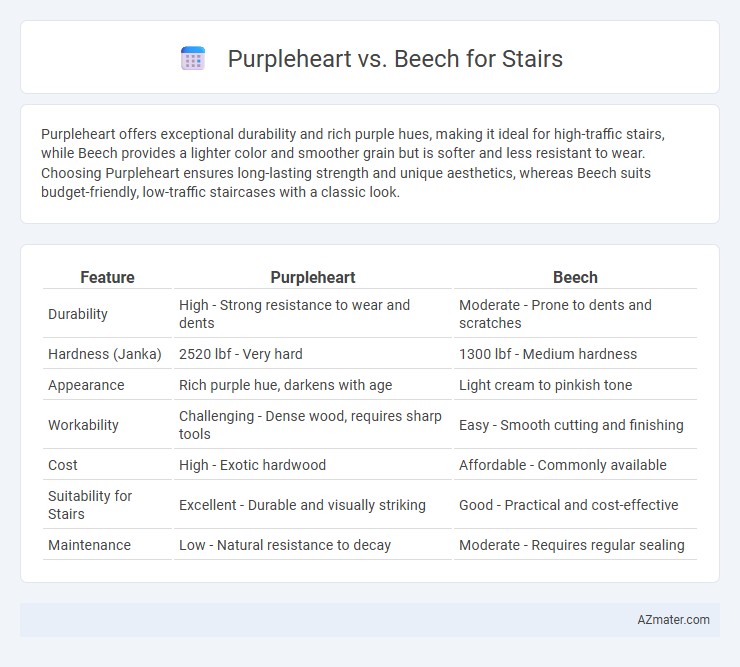Purpleheart offers exceptional durability and rich purple hues, making it ideal for high-traffic stairs, while Beech provides a lighter color and smoother grain but is softer and less resistant to wear. Choosing Purpleheart ensures long-lasting strength and unique aesthetics, whereas Beech suits budget-friendly, low-traffic staircases with a classic look.
Table of Comparison
| Feature | Purpleheart | Beech |
|---|---|---|
| Durability | High - Strong resistance to wear and dents | Moderate - Prone to dents and scratches |
| Hardness (Janka) | 2520 lbf - Very hard | 1300 lbf - Medium hardness |
| Appearance | Rich purple hue, darkens with age | Light cream to pinkish tone |
| Workability | Challenging - Dense wood, requires sharp tools | Easy - Smooth cutting and finishing |
| Cost | High - Exotic hardwood | Affordable - Commonly available |
| Suitability for Stairs | Excellent - Durable and visually striking | Good - Practical and cost-effective |
| Maintenance | Low - Natural resistance to decay | Moderate - Requires regular sealing |
Introduction to Purpleheart and Beech as Stair Materials
Purpleheart, known for its rich purple hue and exceptional hardness, offers high durability and resistance to wear, making it ideal for stair treads and risers in high-traffic areas. Beech features a pale, creamy color with a fine, straight grain, providing a smooth finish and strong structural support suitable for stair stringers and handrails. Both woods balance aesthetic appeal and functional strength, but Purpleheart's superior density and natural resistance to moisture give it an edge for longevity in stair construction.
Overview: Properties of Purpleheart Wood
Purpleheart wood, known for its striking deep purple hue, offers exceptional durability and resistance to wear, making it ideal for high-traffic areas like stairs. Its hardness measures around 2,500 on the Janka scale, significantly surpassing Beech wood, which typically rates near 1,300, indicating superior impact resistance and longevity. The wood's natural oils provide excellent resistance to rot and insects, ensuring long-term stability and minimal maintenance for stair construction.
Overview: Properties of Beech Wood
Beech wood is a dense, hard hardwood known for its smooth texture and fine grain, making it a popular choice for staircases due to its durability and resistance to wear. Its natural light color ranges from pale cream to pinkish hues, providing a versatile aesthetic that can complement various interior styles. Beech offers excellent shock resistance and stability, ensuring long-lasting performance in high-traffic stair applications.
Durability Comparison: Purpleheart vs Beech
Purpleheart wood is significantly more durable than Beech, boasting a Janka hardness of approximately 2,520 lbf compared to Beech's 1,300 lbf, making it highly resistant to dents and wear. Its natural resistance to decay and insects enhances its longevity in stair applications, whereas Beech is more susceptible to moisture damage and surface scratching. The superior strength and density of Purpleheart make it a preferred choice for high-traffic stairs requiring long-lasting performance.
Visual Appeal and Color Variations
Purpleheart staircases showcase a striking deep purple to reddish-brown hue that intensifies with age and exposure to light, creating a bold and exotic visual appeal. Beech stairs offer a lighter, warm cream to pinkish-brown tone with fine, uniform grain patterns that complement traditional and modern interiors alike. Both woods provide unique color variations, with Purpleheart delivering dramatic contrast and Beech ensuring classic, subtle elegance.
Maintenance and Longevity
Purpleheart offers exceptional durability and requires minimal maintenance due to its natural resistance to decay, insects, and wear, making it ideal for high-traffic staircases. Beech, while moderately durable, demands regular sealing and protection from moisture to prevent warping and surface wear, increasing maintenance efforts. Over the long term, Purpleheart's dense and hard composition ensures superior longevity and sustained aesthetic appeal compared to Beech.
Cost Differences: Purpleheart and Beech
Purpleheart wood typically costs between $15 to $25 per board foot, reflecting its exotic source and durability, while Beech averages around $4 to $7 per board foot, making it a more budget-friendly option for stair construction. The higher price of Purpleheart is due to its density, hardness, and vivid purple hue that deepens with exposure, offering a unique aesthetic compared to the lighter and more uniform grain of Beech. Choosing between them involves balancing Purpleheart's premium cost against Beech's affordability and ease of finishing for stair projects.
Workability and Installation
Purpleheart offers exceptional durability and a smooth finish, making it moderately easy to work with hand and power tools, though it requires pre-drilling due to its density. Beech is highly valued for its excellent workability, allowing clean cuts and smooth sanding, which simplifies installation and fitting for staircases. Both woods provide strong structural integrity, but Beech's consistent grain reduces splitting risk, facilitating a faster, more efficient installation process.
Sustainability and Environmental Impact
Purpleheart offers superior sustainability due to its slow growth and dense grain, making it a durable choice that requires less frequent replacement. Beech is a fast-growing hardwood often harvested from managed European forests, promoting responsible forestry practices and lower environmental impact. Choosing Purpleheart or Beech for stairs depends on prioritizing long-lasting durability versus renewable sourcing and lower carbon footprint.
Which Wood is Best for Your Stairs?
Purpleheart offers exceptional durability and a striking deep purple hue that resists wear and adds unique character to stairs, making it ideal for high-traffic areas. Beech provides a lighter, more traditional appearance with fine grain and moderate hardness, offering affordability and ease of finishing for classic stair designs. Selecting the best wood depends on balancing Purpleheart's superior strength and visual impact against Beech's cost-effectiveness and versatility for your stair project.

Infographic: Purpleheart vs Beech for Stair
 azmater.com
azmater.com